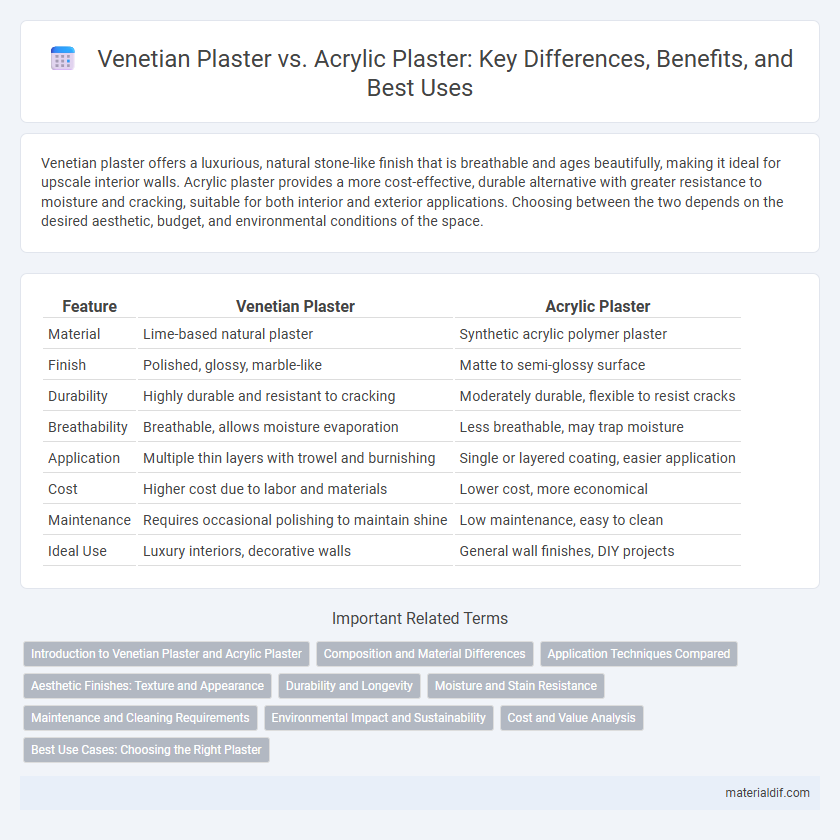Venetian plaster offers a luxurious, natural stone-like finish that is breathable and ages beautifully, making it ideal for upscale interior walls. Acrylic plaster provides a more cost-effective, durable alternative with greater resistance to moisture and cracking, suitable for both interior and exterior applications. Choosing between the two depends on the desired aesthetic, budget, and environmental conditions of the space.
Table of Comparison
| Feature | Venetian Plaster | Acrylic Plaster |
|---|---|---|
| Material | Lime-based natural plaster | Synthetic acrylic polymer plaster |
| Finish | Polished, glossy, marble-like | Matte to semi-glossy surface |
| Durability | Highly durable and resistant to cracking | Moderately durable, flexible to resist cracks |
| Breathability | Breathable, allows moisture evaporation | Less breathable, may trap moisture |
| Application | Multiple thin layers with trowel and burnishing | Single or layered coating, easier application |
| Cost | Higher cost due to labor and materials | Lower cost, more economical |
| Maintenance | Requires occasional polishing to maintain shine | Low maintenance, easy to clean |
| Ideal Use | Luxury interiors, decorative walls | General wall finishes, DIY projects |
Introduction to Venetian Plaster and Acrylic Plaster
Venetian plaster is a decorative finish made from slaked lime and marble dust, known for its rich texture and polished, marble-like appearance that enhances interior walls with a timeless, elegant effect. Acrylic plaster consists of synthetic resin combined with minerals and pigments, offering a flexible, water-resistant surface ideal for both interior and exterior applications. Both plasters serve unique aesthetic and functional roles, with Venetian plaster prized for its classic luxury and acrylic plaster favored for durability and ease of maintenance.
Composition and Material Differences
Venetian plaster is composed primarily of natural lime putty and marble dust, offering a breathable and eco-friendly finish with a smooth, polished surface. Acrylic plaster consists of synthetic polymers combined with pigments and fillers, providing a more flexible, water-resistant coating suitable for modern applications. The natural mineral base of Venetian plaster allows for moisture regulation and durability, while acrylic plaster emphasizes quick drying and enhanced adhesion on diverse substrates.
Application Techniques Compared
Venetian plaster requires multiple thin, polished layers applied with a trowel for a smooth, marble-like finish, demanding skilled handwork and patience. Acrylic plaster is applied in thicker coats using a trowel or roller and dries faster, offering a more straightforward, less labor-intensive technique suitable for quicker projects. The choice between the two depends on the desired texture, finish durability, and application time available.
Aesthetic Finishes: Texture and Appearance
Venetian plaster offers a highly polished, marble-like finish with a smooth, glossy texture that enhances light reflection and adds depth to surfaces. Acrylic plaster provides a more uniform finish with a matte or satin appearance, delivering durability but lacking the natural variegation found in Venetian plaster. The choice between these plasters depends on desired aesthetic effects, with Venetian plaster favored for luxurious, textured designs and acrylic plaster suited for consistent, easy-to-maintain surfaces.
Durability and Longevity
Venetian plaster exhibits superior durability due to its natural lime base, which hardens over time and resists cracking and chipping, making it ideal for high-traffic areas. Acrylic plaster, while faster to apply and more flexible, is prone to fading and may require frequent touch-ups, reducing its overall longevity. The mineral composition of Venetian plaster contributes to its long-lasting finish and resistance to moisture compared to the synthetic polymers in acrylic plaster.
Moisture and Stain Resistance
Venetian plaster offers moderate moisture resistance due to its lime-based composition, which allows walls to breathe while providing some protection against dampness. Acrylic plaster, made from synthetic polymers, typically provides superior moisture and stain resistance, creating a more durable and water-resistant surface ideal for high-humidity areas. Both finishes require proper sealing to enhance stain resistance, but acrylic plaster generally outperforms Venetian plaster in maintaining appearance in moist environments.
Maintenance and Cleaning Requirements
Venetian plaster requires gentle cleaning with a soft cloth and mild soap to maintain its polished, marble-like finish, as harsh chemicals can damage its surface. Acrylic plaster is more durable and resistant to stains, allowing for easier cleaning with water-based solutions and occasional mild detergents. Regular maintenance of Venetian plaster includes periodic polishing to retain its sheen, while acrylic plaster typically demands less frequent upkeep.
Environmental Impact and Sustainability
Venetian plaster, made from natural lime and marble dust, offers superior environmental benefits due to its biodegradability and low VOC emissions compared to acrylic plaster, which often contains synthetic polymers and chemical additives. The production of Venetian plaster typically has a lower carbon footprint, as it uses natural materials and requires less energy-intensive processes. Choosing Venetian plaster supports sustainability goals by reducing indoor air pollution and contributing to healthier, eco-friendly building practices.
Cost and Value Analysis
Venetian plaster generally costs between $8 to $15 per square foot, reflecting its premium finish and durability, while acrylic plaster ranges from $3 to $7 per square foot, offering a budget-friendly alternative. Although Venetian plaster demands a higher initial investment, its value lies in long-lasting elegance and resistance to moisture and cracking, reducing maintenance costs over time. Acrylic plaster provides cost efficiency for short-term projects but may require more frequent repairs and repainting, impacting overall lifecycle value.
Best Use Cases: Choosing the Right Plaster
Venetian plaster is ideal for achieving a high-end, polished marble-like finish in interior walls, perfect for luxury homes, feature walls, and upscale commercial spaces due to its durability and elegant gloss. Acrylic plaster offers greater flexibility, quick drying time, and is suitable for both interior and exterior surfaces, making it the preferred choice for renovation projects, high-moisture areas, and budget-conscious installations. Selecting between Venetian and acrylic plaster depends on desired aesthetics, environmental conditions, and budget, ensuring optimal performance and visual appeal.
Venetian plaster vs Acrylic plaster Infographic

 materialdif.com
materialdif.com